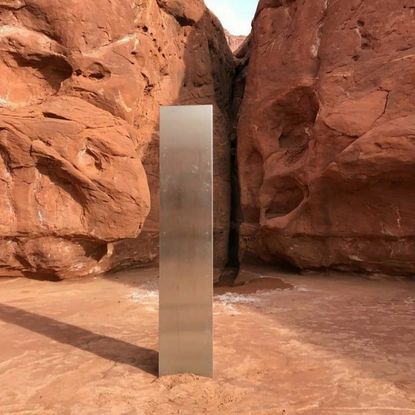Mysterious monolith pops up in Romania as Utah version vanishes
Authorities in both Europe and US baffled by unexplained additions to landscapes

Conspiracy theorists have been handed an early Christmas present in the form of the mysterious appearance of metal monolith on a hillside in Romania as a similar unexplained structure vanishes from the Utah desert.
The giant triangular pillar in Romania was found on Batca Doamnei Hill, facing Mount Ceahlau - known locally as the Holy Mountain - in the northern city of Piatra Neamt last Thursday.
The 13ft-tall structure “is covered in a looping scrawl” and “bears a resemblance to the Utah monolith which was spotted in a remote cove” by a passing helicopter a couple of weeks ago - “leading people to wonder if the monuments are linked”, says Sky News.
Subscribe to The Week
Escape your echo chamber. Get the facts behind the news, plus analysis from multiple perspectives.

Sign up for The Week's Free Newsletters
From our morning news briefing to a weekly Good News Newsletter, get the best of The Week delivered directly to your inbox.
From our morning news briefing to a weekly Good News Newsletter, get the best of The Week delivered directly to your inbox.
“In a bizarre twist”, the Utah Bureau of Land Management says the desert pillar was removed by “an unknown party” last Friday, the broadcaster adds.
The authorities in Romania are equally baffled by their “peculiar find”, which stands on protected land just metres from the site of a famous ancient fortress, says the Daily Mail.
So as the newspaper asks, “who (or what) put it there?”
Some armchair-sleuths have suggested that the metal slab may be “the work of aliens”, while others believe it was probably created by a prankster inspired by science fiction novel 2001: A Space Odyssey. In Arthur C. Clarke’s classic book, a monolith appears on Earth and seems to accelerate the learning of a tribe of ape-men.
Some eagle-eyed observers have also compared the unexplained structures to works by American minimalist sculpture John McCracken, who died in 2011.
Whatever the explanation, “it has been a tough few days for unorthodox, mystery monuments”, says The Guardian.
Police in Germany are investigating the disappearance of “a large wooden sculpture of a phallus” from a mountainside in southern Bavaria that “appeared without explanation several years ago”, the newspaper reports.
The giant penis is not believed to be linked to the metal monoliths, however.
Create an account with the same email registered to your subscription to unlock access.
Sign up for Today's Best Articles in your inbox
A free daily email with the biggest news stories of the day – and the best features from TheWeek.com
Kari Wilkin is The Week Digital’s global managing editor. She joined the UK site as production editor in 2017, after moving across from The Week magazine. Her career as a journalist began as a sub-editor at newspapers including The Sun, Metro, the Daily Star and News of the World, followed by stints at Elle and Asda Magazine. She also helped to launch the UK edition of Women’s Health magazine, as chief sub-editor with a sideline in writing; has penned travel and lifestyle articles for titles including The Telegraph and The Sun; and is a contributor on “The Week Unwrapped” podcast.
-
 'Good riddance to the televised presidential debate'
'Good riddance to the televised presidential debate'Instant Opinion Opinion, comment and editorials of the day
By Harold Maass, The Week US Published
-
 Caitlin Clark the No. 1 pick in bullish WNBA Draft
Caitlin Clark the No. 1 pick in bullish WNBA DraftSpeed Read As expected, she went to the Indiana Fever
By Peter Weber, The Week US Published
-
 Today's political cartoons - April 16, 2024
Today's political cartoons - April 16, 2024Cartoons Tuesday's cartoons - sleepyhead, little people, and more
By The Week US Published
-
 Puffed rice and yoga: inside the collapsed tunnel where Indian workers await rescue
Puffed rice and yoga: inside the collapsed tunnel where Indian workers await rescueSpeed Read Workers trapped in collapsed tunnel are suffering from dysentery and anxiety over their rescue
By Sorcha Bradley, The Week UK Published
-
 Gaza hospital blast: What the video evidence shows about who's to blame
Gaza hospital blast: What the video evidence shows about who's to blameSpeed Read Nobody wants to take responsibility for the deadly explosion in the courtyard of Gaza's al-Ahli Hospital. Roll the tape.
By Peter Weber, The Week US Published
-
 Giraffe poo seized after woman wanted to use it to make a necklace
Giraffe poo seized after woman wanted to use it to make a necklaceTall Tales And other stories from the stranger side of life
By Chas Newkey-Burden, The Week UK Published
-
 Helicopter sound arouses crocodiles
Helicopter sound arouses crocodilesTall Tales And other stories from the stranger side of life
By Chas Newkey-Burden, The Week UK Published
-
 Woman sues Disney over 'injurious wedgie'
Woman sues Disney over 'injurious wedgie'Tall Tales And other stories from the stranger side of life
By Chas Newkey-Burden, The Week UK Published
-
 Emotional support alligator turned away from baseball stadium
Emotional support alligator turned away from baseball stadiumTall Tales And other stories from the stranger side of life
By Chas Newkey-Burden, The Week UK Published
-
 Europe's oldest shoes found in Spanish caves
Europe's oldest shoes found in Spanish cavesTall Tales And other stories from the stranger side of life
By Chas Newkey-Burden, The Week UK Published
-
 Artworks stolen by Nazis returned to heirs of cabaret performer
Artworks stolen by Nazis returned to heirs of cabaret performerIt wasn't all bad Good news stories from the past seven days
By The Week Staff Published